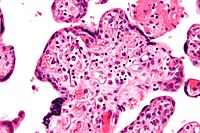
Photo from wikipedia
Objective: The paper uses ultrasound Doppler fetal heart rate detection algorithm to explore the placental characteristics of monochorionic twin pregnancy with selective fetal growth restriction, and discuss the correlation between… Click to show full abstract
Objective: The paper uses ultrasound Doppler fetal heart rate detection algorithm to explore the placental characteristics of monochorionic twin pregnancy with selective fetal growth restriction, and discuss the correlation between selective fetal growth restriction and cord blood SFass FasL level. Methods: From June 1, 2019 to June 1, 2020 in our hospital, 23 cases of selective fetal growth restriction and 32 cases of uncomplicated cases were included in the monochorionic twin pregnancies whose pregnancy was terminated in our hospital (control group) research. Perfusion was completed within 24 hours after delivery of the placenta. The umbilical arteries and veins of the two fetuses were respectively perfused with four different colors of pigments. The type of anastomoses was judged according to the color of the blood vessels on the placenta surface. Results: The selective fetal growth restriction group was higher than the control group. In the selective fetal growth restriction group and the control group, the number of anastomoses of the placental superficial arterial artery, arterial vein and venous vein were 1.0 and 1.0, 3.0 and 2.0, 0.0 and 0.0, respectively; the placental superficial arterial artery, arterial vein and venous vein. The total diameters of the anastomosed blood vessels were 2.7 and 2.2, 4.0 and 3.4, 0.0 and 0.0 mm, respectively; the total number of superficial placental anastomosed blood vessels in the selective fetal growth restriction group and the control group were 3.5 and 3.5, respectively.The total diameters were 6.9 and 6.9, respectively 5.9mm. Conclusion: Uneven placental share and non-central attachment of the umbilical cord may be risk factors for selective fetal growth restriction in monochorionic twin pregnancy.
Journal Title: Pakistan Journal of Medical Sciences
Year Published: 2021
Link to full text (if available)
Share on Social Media: Sign Up to like & get
recommendations!